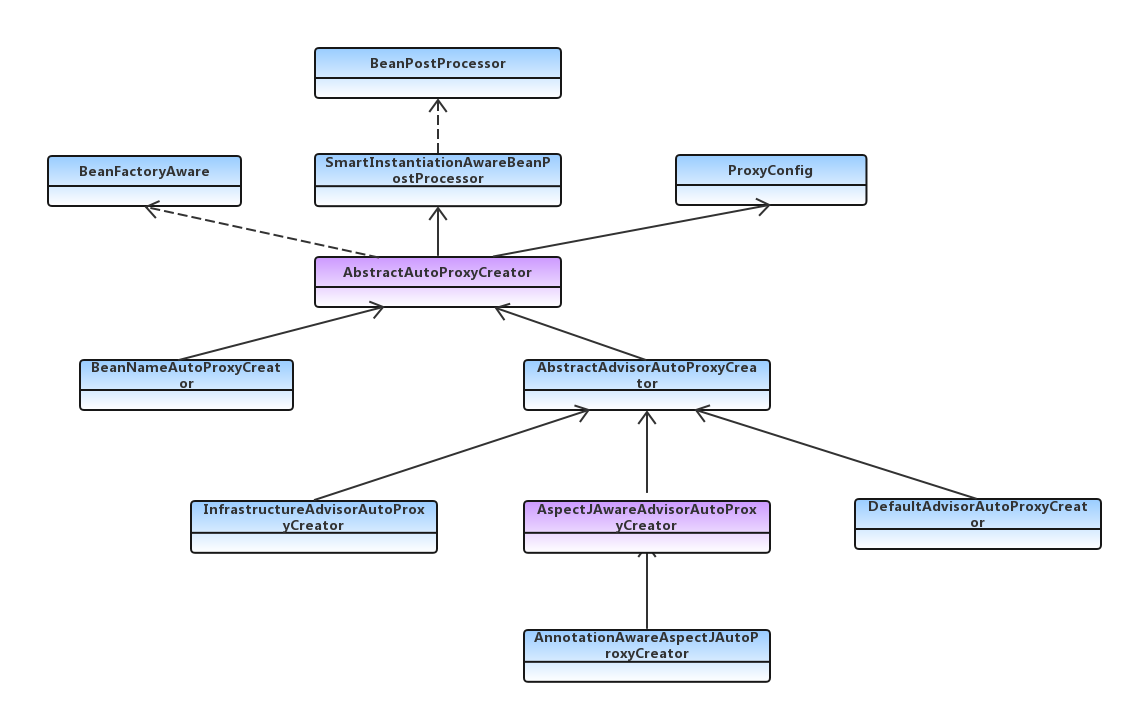SpringBoot2 | Spring AOP 原理原始碼深度剖析(八)
微信公眾號:吉姆餐廳ak
學習更多原始碼知識,歡迎關注。
概述
AOP(Aspect-Oriented Programming) 面向切面程式設計。Spring Aop 在 Spring框架中的地位舉足輕重,具體優勢和場景就不介紹了,本篇主要是對原始碼進行深度分析。
先來介紹一些核心的 API。
API
先介紹一些Spring Aop中一些比較核心的API,大致分為三類:
advisorCreator,繼承 spring ioc的擴充套件介面 beanPostProcessor,主要用來掃描獲取 advisoradvisor:顧問的意思,封裝了spring aop中的切點和通知。advice:通知,也就是aop中增強的方法。
對以上三類核心 API 對應的 UML 分別來看。
advisorCreator:

-
AbstractAutoProxyCreator:Spring 為Spring AOP 模組暴露的可擴充套件抽象類,也是 AOP 中最核心的抽象類。Nepxion Matrix框架便是基於此類對AOP進行擴充套件和增強。 -
BeanNameAutoProxyCreator:根據指定名稱建立代理物件(阿里大名鼎鼎的連線池框架druid也基於此類做了擴充套件)。通過設定 advisor,可以對指定的 beanName 進行代理。支援模糊匹配。 -
AbstractAdvisorAutoProxyCreator:功能比較強大,預設掃描所有Advisor的實現類。相對於根據Bean名稱匹配,該類更加靈活。動態的匹配每一個類,判斷是否可以被代理,並尋找合適的增強類,以及生成代理類。 -
DefaultAdvisorAutoProxyCreator:AbstractAdvisorAutoProxyCreator的預設實現類。可以單獨使用,在框架中使用AOP,儘量不要手動建立此物件。 -
AspectJAwareAdvisorAutoProxyCreator:Aspectj的實現方式,也是Spring Aop中最常用的實現方式,如果用註解方式,則用其子類AnnotationAwareAspectJAutoProxyCreator。 -
AnnotationAwareAspectJAutoProxyCreator:目前最常用的AOP使用方式。spring aop 開啟註解方式之後,該類會掃描所有@Aspect()標準的類,生成對應的adviosr。目前SpringBoot框架中預設支援的方式,自動配置。
advisor:

-
StaticMethodMatcherPointcut:靜態方法切面,抽象類。定義了一個classFilter,通過重寫getClassFilter()方法來指定切面規則。另外實現了StaticMethodMatcher介面,通過重寫matches來指定方法匹配規則。 -
StaticMethodMatcherPointcutAdvisor:靜態方法匹配切面顧問,同未抽象類,擴充套件了切面排序方法。 -
NameMatchMethodPointcut:名稱匹配切面,通過指定方法集合變數mappedNames,模糊匹配。 -
NameMatchMethodPointcutAdvisor:方法名稱切面顧問,內部封裝了
NameMatchMethodPointcut,通過設定方法名稱模糊匹配規則和通知來實現切面功能。 -
RegexpMethodPointcutAdvisor:正則表示式切面顧問,可設定多個正則表示式規則,通過內部封裝的
JdkRegexpMethodPointcut解析正則表示式。 -
DefaultPointcutAdvisor:預設切面顧問,比較靈活。可自由組合切面和通知。 -
InstantiationModelAwarePointcutAdvisorImpl:springboot自動裝配的顧問型別,也是最常用的一種顧問實現。在註解實現的切面中,所有@Aspect類,都會被解析成該物件。
advice:

-AspectJMethodBeforeAdvice:前置通知,AspectJ中 before 屬性對應的通知(@Before標註的方法會被解析成該通知),,在切面方法執行之前執行。
-AspectJAfterReturningAdvice:後置通知,AspectJ中 afterReturning 屬性對應的通知(@AfterReturning 標註的方法會被解析成該通知),在切面方法執行之後執行,如果有異常,則不執行。
注意:該通知與AspectJMethodBeforeAdvice對應。
-AspectJAroundAdvice:環繞通知,AspectJ中 around 屬性對應的通知(@Around標註的方法會被解析成該通知),在切面方法執行前後執行。
-AspectJAfterAdvice:返回通知,AspectJ中 after 屬性對應的通知(@After 標註的方法會被解析成該通知),不論是否異常都會執行。
原始碼
以上 API原始碼眾多,這裡就針對AOP方式進行原始碼分析。
示例:
@Aspect
@Component
public class LogableAspect {
@Pointcut("@annotation(com.springboot2.spring5.springAop.aspect.Logable)")
public void aspect() {
}
@Around("aspect()")
public Object doAround(ProceedingJoinPoint point) throws Throwable {
//...
Object returnValue = point.proceed(point.getArgs());
//...
return returnValue;
}
}
這是實際專案中,使用AOP最常見的形式,基於註解實現。。如今springboot大行其道,我們就從springboot中的EnableAspectJAutoProxy開始,針對 AOP 的註解實現方式進行剖析。
大致流程主要分為三個步驟:
一: 建立AnnotationAwareAspectJAutoProxyCreator物件
二: 掃描容器中的切面,建立PointcutAdvisor物件
三: 生成代理類
分別來分析以上三個步驟。
一: 建立AnnotationAwareAspectJAutoProxyCreator物件
首先來看AnnotationAwareAspectJAutoProxyCreator物件初始化的過程。springboot中,aop同樣以自動裝配的方式,所以還是要從spring.factories開始:
# Auto Configure
org.springframework.boot.autoconfigure.aop.AopAutoConfiguration,\
@Configuration
@ConditionalOnClass({ EnableAspectJAutoProxy.class, Aspect.class, Advice.class,
AnnotatedElement.class })
@ConditionalOnProperty(prefix = "spring.aop", name = "auto", havingValue = "true", matchIfMissing = true)
public class AopAutoConfiguration {
@Configuration
@EnableAspectJAutoProxy(proxyTargetClass = false)
@ConditionalOnProperty(prefix = "spring.aop", name = "proxy-target-class", havingValue = "false", matchIfMissing = false)
public static class JdkDynamicAutoProxyConfiguration {
}
@Configuration
@EnableAspectJAutoProxy(proxyTargetClass = true)
@ConditionalOnProperty(prefix = "spring.aop", name = "proxy-target-class", havingValue = "true", matchIfMissing = true)
public static class CglibAutoProxyConfiguration {
}
}
具體來看:
1)該配置類的載入前提是什麼?
@ConditionalOnClass({ EnableAspectJAutoProxy.class, Aspect.class, Advice.class,
AnnotatedElement.class })
條件註解依賴的配置類均被引入到spring-boot-starter-aop中,只需引入該依賴即可自動裝配。
而且可以看到spring.aop.auto預設為true,並不需要手動開啟。
所以很多同學在springboot專案中使用 aop 的時候,習慣在啟動類上引入@EnableAspectJAutoProxy,其實完全不必要。保證專案中有spring-boot-starter-aop依賴即可。
2)上述程式碼通過spring.aop.proxy-target-class變數來控制proxyTargetClass的變數,最終都會載入@EnableAspectJAutoProxy配置。
spring.aop.proxy-target-class預設為true,該變數相當關鍵,控制 spring aop 代理類的生成方式,具體後面詳細介紹。
繼續跟進EnableAspectJAutoProxy:
class AspectJAutoProxyRegistrar implements ImportBeanDefinitionRegistrar {
@Override
public void registerBeanDefinitions(
AnnotationMetadata importingClassMetadata, BeanDefinitionRegistry registry) {
//註冊 AnnotationAwareAspectJAutoProxyCreator
AopConfigUtils.registerAspectJAnnotationAutoProxyCreatorIfNecessary(registry);
AnnotationAttributes enableAspectJAutoProxy =
AnnotationConfigUtils.attributesFor(importingClassMetadata, EnableAspectJAutoProxy.class);
//將 aop 代理方式相關的變數設定到 AopConfigUtils,建立代理類時會讀取變數
if (enableAspectJAutoProxy != null) {
if (enableAspectJAutoProxy.getBoolean("proxyTargetClass")) {
AopConfigUtils.forceAutoProxyCreatorToUseClassProxying(registry);
}
if (enableAspectJAutoProxy.getBoolean("exposeProxy")) {
AopConfigUtils.forceAutoProxyCreatorToExposeProxy(registry);
}
}
}
}
@Nullable
public static BeanDefinition registerAspectJAnnotationAutoProxyCreatorIfNecessary(BeanDefinitionRegistry registry,
@Nullable Object source) {
return registerOrEscalateApcAsRequired(AnnotationAwareAspectJAutoProxyCreator.class, registry, source);
}
上述程式碼可以看到註冊了一個切面相關BeanDefinition,正是上面提到的類:
AnnotationAwareAspectJAutoProxyCreator,並設定了代理方式配置變數: proxyTargetClass,預設為true。
這裡只是建立BeanDefinition,並沒有例項化和初始化該物件。那什麼時候會觸發呢?
上面的 uml 圖可以看到,該類繼承的頂層介面為 BeanPostProcessor。我們知道BeanPostProcessor實現類會提前初始化,由PostProcessorRegistrationDelegate觸發,具體細節之前部落格有提到:
SpringBoot2 | @SpringBootApplication註解 自動化配置流程原始碼分析(三)
該類又繼承BeanFactoryAware,所以在其在例項化 bean 後,會觸發setBeanFactory()方法,最終會觸發
initBeanFactory方法:
@Override
protected void initBeanFactory(ConfigurableListableBeanFactory beanFactory) {
super.initBeanFactory(beanFactory);
if (this.aspectJAdvisorFactory == null) {
//advisor 工廠類
this.aspectJAdvisorFactory = new ReflectiveAspectJAdvisorFactory(beanFactory);
}
//用於建立 advisor
this.aspectJAdvisorsBuilder =
new BeanFactoryAspectJAdvisorsBuilderAdapter(beanFactory, this.aspectJAdvisorFactory);
}
至此,AnnotationAwareAspectJAutoProxyCreator BeanDefinition建立完畢。
二: 掃描容器中的切面,建立PointcutAdvisor物件
在spring ioc流程載入的過程中,會觸發 beanPostProcessor 擴充套件介面,
而AnnotationAwareAspectJAutoProxyCreator又是SmartInstantiationAwareBeanPostProcessor的子類,所以該擴充套件介面正是 aop 實現的入口。
該介面的觸發在例項化 bean 之後,初始化 bean之前,具體來看:
@Override
public Object postProcessBeforeInstantiation(Class<?> beanClass, String beanName) throws BeansException {
Object cacheKey = getCacheKey(beanClass, beanName);
if (!StringUtils.hasLength(beanName) || !this.targetSourcedBeans.contains(beanName)) {
//advisedBeans用於儲存不可代理的bean,如果包含直接返回
if (this.advisedBeans.containsKey(cacheKey)) {
return null;
}
//判斷當前bean是否可以被代理,然後存入advisedBeans
if (isInfrastructureClass(beanClass) || shouldSkip(beanClass, beanName)) {
this.advisedBeans.put(cacheKey, Boolean.FALSE);
return null;
}
}
// Create proxy here if we have a custom TargetSource.
// Suppresses unnecessary default instantiation of the target bean:
// The TargetSource will handle target instances in a custom fashion.
//到這裡說明該bean可以被代理,所以去獲取自定義目標類,如果沒有定義,則跳過。
TargetSource targetSource = getCustomTargetSource(beanClass, beanName);
if (targetSource != null) {
if (StringUtils.hasLength(beanName)) {
this.targetSourcedBeans.add(beanName);
}
Object[] specificInterceptors = getAdvicesAndAdvisorsForBean(beanClass, beanName, targetSource);
Object proxy = createProxy(beanClass, beanName, specificInterceptors, targetSource);
this.proxyTypes.put(cacheKey, proxy.getClass());
//如果最終可以獲得代理類,則返回代理類,直接執行例項化後置通知方法
return proxy;
}
return null;
}
來看一下判定 bean 是否被代理的方法依據:
@Override
protected boolean isInfrastructureClass(Class<?> beanClass) {
return (super.isInfrastructureClass(beanClass) ||
(this.aspectJAdvisorFactory != null && this.aspectJAdvisorFactory.isAspect(beanClass)));
}
private boolean hasAspectAnnotation(Class<?> clazz) {
//判定當前類是否有 Aspect 註解,如果有,則不能被代理
return (AnnotationUtils.findAnnotation(clazz, Aspect.class) != null);
}
protected boolean isInfrastructureClass(Class<?> beanClass) {
//判定當前bean是否是 Advice、Pointcut、Advisor、AopInfrastructureBean等子類或實現類,如果是,則不能被代理
boolean retVal = Advice.class.isAssignableFrom(beanClass) ||
Pointcut.class.isAssignableFrom(beanClass) ||
Advisor.class.isAssignableFrom(beanClass) ||
AopInfrastructureBean.class.isAssignableFrom(beanClass);
if (retVal && logger.isTraceEnabled()) {
logger.trace("Did not attempt to auto-proxy infrastructure class [" + beanClass.getName() + "]");
}
return retVal;
}
重點來看 shouldSkip方法:
@Override
protected boolean shouldSkip(Class<?> beanClass, String beanName) {
// TODO: Consider optimization by caching the list of the aspect names
//獲取所有的候選顧問類 Advisor
List<Advisor> candidateAdvisors = findCandidateAdvisors();
for (Advisor advisor : candidateAdvisors) {
if (advisor instanceof AspectJPointcutAdvisor &&
((AspectJPointcutAdvisor) advisor).getAspectName().equals(beanName)) {
return true;
}
}
return super.shouldSkip(beanClass, beanName);
}
跟進 findCandidateAdvisors();方法:
@Override
protected List<Advisor> findCandidateAdvisors() {
// Add all the Spring advisors found according to superclass rules.
//獲得 Advisor 實現類
List<Advisor> advisors = super.findCandidateAdvisors();
// Build Advisors for all AspectJ aspects in the bean factory.
//將@Aspect註解類, 解析成Advisor
if (this.aspectJAdvisorsBuilder != null) {
advisors.addAll(this.aspectJAdvisorsBuilder.buildAspectJAdvisors());
}
return advisors;
}
繼續跟進buildAspectJAdvisors方法,會觸發
ReflectiveAspectJAdvisorFactory中的getAdvisors方法:
@Override
public List<Advisor> getAdvisors(MetadataAwareAspectInstanceFactory aspectInstanceFactory) {
//從 aspectMetadata 中獲取 Aspect()標註的類 class物件
Class<?> aspectClass = aspectInstanceFactory.getAspectMetadata().getAspectClass();
//獲取Aspect()標註的類名
String aspectName = aspectInstanceFactory.getAspectMetadata().getAspectName();
validate(aspectClass);
// We need to wrap the MetadataAwareAspectInstanceFactory with a decorator
// so that it will only instantiate once.
MetadataAwareAspectInstanceFactory lazySingletonAspectInstanceFactory =
new LazySingletonAspectInstanceFactoryDecorator(aspectInstanceFactory);
List<Advisor> advisors = new LinkedList<>();
//遍歷該類所有方法,根據方法判斷是否能獲取到對應 pointCut,如果有,則生成 advisor 物件
for (Method method : getAdvisorMethods(aspectClass)) {
Advisor advisor = getAdvisor(method, lazySingletonAspectInstanceFactory, advisors.size(), aspectName);
if (advisor != null) {
advisors.add(advisor);
}
}
// If it's a per target aspect, emit the dummy instantiating aspect.
if (!advisors.isEmpty() && lazySingletonAspectInstanceFactory.getAspectMetadata().isLazilyInstantiated()) {
Advisor instantiationAdvisor = new SyntheticInstantiationAdvisor(lazySingletonAspectInstanceFactory);
advisors.add(0, instantiationAdvisor);
}
// Find introduction fields.
//獲取 @DeclareParents 註解修飾的屬性(並不常用)
for (Field field : aspectClass.getDeclaredFields()) {
Advisor advisor = getDeclareParentsAdvisor(field);
if (advisor != null) {
advisors.add(advisor);
}
}
return advisors;
}
繼續來看getAdvisor方法:
@Override
@Nullable
public Advisor getAdvisor(Method candidateAdviceMethod, MetadataAwareAspectInstanceFactory aspectInstanceFactory,
int declarationOrderInAspect, String aspectName) {
validate(aspectInstanceFactory.getAspectMetadata().getAspectClass());
//根據候選方法名,來獲取對應的 pointCut
AspectJExpressionPointcut expressionPointcut = getPointcut(
candidateAdviceMethod, aspectInstanceFactory.getAspectMetadata().getAspectClass());
if (expressionPointcut == null) {
return null;
}
//如果能獲取到 pointCut,則將切點表示式 expressionPointcut、當前
物件ReflectiveAspectJAdvisorFactory、 方法名等包裝成 advisor 物件
return new InstantiationModelAwarePointcutAdvisorImpl(expressionPointcut, candidateAdviceMethod,
this, aspectInstanceFactory, declarationOrderInAspect, aspectName);
}
protected static AspectJAnnotation<?> findAspectJAnnotationOnMethod(Method method) {
//定義class物件陣列,如果方法中有以下註解中任何一種,則返回該註解
Class<?>[] classesToLookFor = new Class<?>[] {
Before.class, Around.class, After.class, AfterReturning.class, AfterThrowing.class, Pointcut.class};
for (Class<?> c : classesToLookFor) {
AspectJAnnotation<?> foundAnnotation = findAnnotation(method, (Class<Annotation>) c);
if (foundAnnotation != null) {
return foundAnnotation;
}
}
return null;
}
InstantiationModelAwarePointcutAdvisorImpl的構造方法會觸發構造通知物件:
public Advice getAdvice(Method candidateAdviceMethod, AspectJExpressionPointcut expressionPointcut,
MetadataAwareAspectInstanceFactory aspectInstanceFactory, int declarationOrder, String aspectName) {
//......
//根據註解型別,匹配對應的通知型別
switch (aspectJAnnotation.getAnnotationType()) {
//前置通知
case AtBefore:
springAdvice = new AspectJMethodBeforeAdvice(
candidateAdviceMethod, expressionPointcut, aspectInstanceFactory);
break;
//最終通知
case AtAfter:
springAdvice = new AspectJAfterAdvice(
candidateAdviceMethod, expressionPointcut, aspectInstanceFactory);
break;
//後置通知
case AtAfterReturning:
springAdvice = new AspectJAfterReturningAdvice(
candidateAdviceMethod, expressionPointcut, aspectInstanceFactory);
AfterReturning afterReturningAnnotation = (AfterReturning) aspectJAnnotation.getAnnotation();
if (StringUtils.hasText(afterReturningAnnotation.returning())) {
springAdvice.setReturningName(afterReturningAnnotation.returning());
}
break;
//異常通知
case AtAfterThrowing:
springAdvice = new AspectJAfterThrowingAdvice(
candidateAdviceMethod, expressionPointcut, aspectInstanceFactory);
AfterThrowing afterThrowingAnnotation = (AfterThrowing) aspectJAnnotation.getAnnotation();
if (StringUtils.hasText(afterThrowingAnnotation.throwing())) {
springAdvice.setThrowingName(afterThrowingAnnotation.throwing());
}
break;
//環繞通知
case AtAround:
springAdvice = new AspectJAroundAdvice(
candidateAdviceMethod, expressionPointcut, aspectInstanceFactory);
break;
//切面
case AtPointcut:
if (logger.isDebugEnabled()) {
logger.debug("Processing pointcut '" + candidateAdviceMethod.getName() + "'");
}
return null;
default:
throw new UnsupportedOperationException(
"Unsupported advice type on method: " + candidateAdviceMethod);
}
//......
}
可以看到,根據@Aspect類中方法的註解型別,生成對應的advice,並通過通知的構造方法,將通知增強方法,切面表示式傳入到通知當中。
到這裡InstantiationModelAwarePointcutAdvisorImpl物件構造完畢。
三: 生成代理類
上面建立advisor的邏輯發生在擴充套件介面中的postProcessBeforeInstantiation,例項化之前執行,如果有自定義的TargetSource指定類,則則直接生成代理類,並直接執行初始化之後的方法postProcessAfterInitialization。這種情況使用不多,常規代理類還是在postProcessAfterInitialization中建立,也就是 IOC 最後一個擴充套件方法。
@Override
public Object postProcessAfterInitialization(@Nullable Object bean, String beanName) throws BeansException {
if (bean != null) {
Object cacheKey = getCacheKey(bean.getClass(), beanName);
//處理迴圈依賴的判斷
if (!this.earlyProxyReferences.contains(cacheKey)) {
return wrapIfNecessary(bean, beanName, cacheKey);
}
}
return bean;
}
protected Object wrapIfNecessary(Object bean, String beanName, Object cacheKey) {
if (StringUtils.hasLength(beanName) && this.targetSourcedBeans.contains(beanName)) {
return bean;
}
if (Boolean.FALSE.equals(this.advisedBeans.get(cacheKey))) {
return bean;
}
if (isInfrastructureClass(bean.getClass()) || shouldSkip(bean.getClass(), beanName)) {
this.advisedBeans.put(cacheKey, Boolean.FALSE);
return bean;
}
// Create proxy if we have advice.
//獲取到合適的advisor,如果為空。如果不為空,則生成代理類。
Object[] specificInterceptors = getAdvicesAndAdvisorsForBean(bean.getClass(), beanName, null);
if (specificInterceptors != DO_NOT_PROXY) {
this.advisedBeans.put(cacheKey, Boolean.TRUE);
Object proxy = createProxy(
bean.getClass(), beanName, specificInterceptors, new SingletonTargetSource(bean));
this.proxyTypes.put(cacheKey, proxy.getClass());
return proxy;
}
this.advisedBeans.put(cacheKey, Boolean.FALSE);
return bean;
}
跟進findEligibleAdvisors:
protected List<Advisor> findEligibleAdvisors(Class<?> beanClass, String beanName) {
List<Advisor> candidateAdvisors = findCandidateAdvisors();
//這裡會對獲取的advisor進行篩選
List<Advisor> eligibleAdvisors = findAdvisorsThatCanApply(candidateAdvisors, beanClass, beanName);
//新增一個預設的advisor,執行時用到。
extendAdvisors(eligibleAdvisors);
if (!eligibleAdvisors.isEmpty()) {
eligibleAdvisors = sortAdvisors(eligibleAdvisors);
}
return eligibleAdvisors;
}
具體的advisor篩選規則在AopUtils中:
public static List<Advisor> findAdvisorsThatCanApply(List<Advisor> candidateAdvisors, Class<?> clazz) {
//......
for (Advisor candidate : candidateAdvisors) {
if (candidate instanceof IntroductionAdvisor) {
// already processed
continue;
}
if (canApply(candidate, clazz, hasIntroductions)) {
eligibleAdvisors.add(candidate);
}
}
//......
}
規則就是遍歷所有的方法,跟進切面表示式進行匹配,如果有一個方法匹配到,也就意味著該類會被代理。
重點來看一下代理生成方式:
public AopProxy createAopProxy(AdvisedSupport config) throws AopConfigException {
if (config.isOptimize() || config.isProxyTargetClass() || hasNoUserSuppliedProxyInterfaces(config)) {
Class<?> targetClass = config.getTargetClass();
if (targetClass == null) {
throw new AopConfigException("TargetSource cannot determine target class: " +
"Either an interface or a target is required for proxy creation.");
}
//如果代理目標是介面或者Proxy型別,則走jdk型別
if (targetClass.isInterface() || Proxy.isProxyClass(targetClass)) {
return new JdkDynamicAopProxy(config);
}
return new ObjenesisCglibAopProxy(config);
}
else {
return new JdkDynamicAopProxy(config);
}
}
上述方法通過三個變數來進行篩選代理方法:
optimize:官方文件翻譯為設定代理是否應執行積極的優化,預設為false。proxyTargetClass:這個在上面已經提到了,AopAutoConfiguration中指定,預設為true,也就是選擇使用 cglib 代理。可以看到該變數和optimize意義一樣,之所以這麼做,個人理解是為了可以在不同的場景中使用。hasNoUserSuppliedProxyInterfaces:是否指定了代理介面,預設情況下用不到該方法。
可以看到如果用預設配置也就是proxyTargetClass為true時,只有一種情況會走jdk代理方法,就是代理類為介面型別(注意:代理類是介面型別,並不是指介面類是否實現了介面)或者代理類是Proxy型別,否則全部走cglib代理。所以,平時使用中,代理類大部分還是用cglib的方式來生成。

